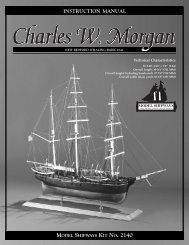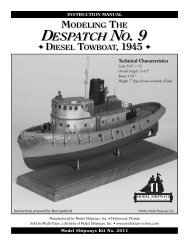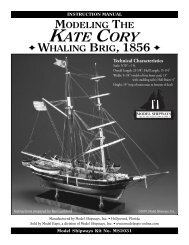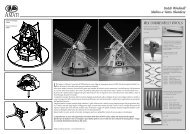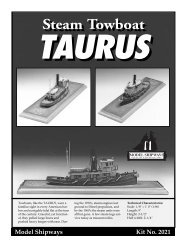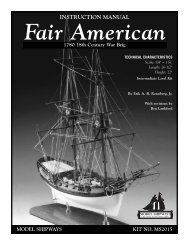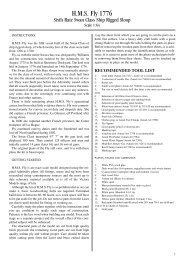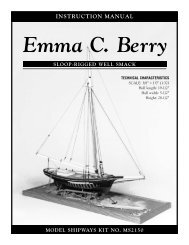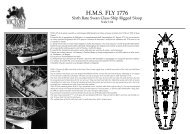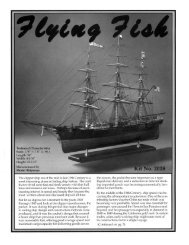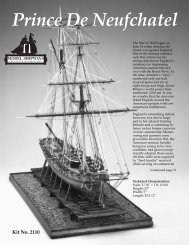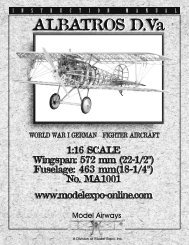download benjamin latham instruction manual
download benjamin latham instruction manual
download benjamin latham instruction manual
You also want an ePaper? Increase the reach of your titles
YUMPU automatically turns print PDFs into web optimized ePapers that Google loves.
Procedure: The fishing schooners had a very unusual deck<br />
planking layout and nibbing arrangement, so follow the plans<br />
carefully (see figure 20i also). Cut the nibs into the edge of the<br />
planksheer as you go.<br />
The fore deck plank should be laid parallel to the centerline.<br />
Start at the centerline and work outboard. Scrape off any glue<br />
squeeze-out before going to the next plank. Planking butts can<br />
be used, like the outer hull, or they may be omitted. On a real<br />
ship, they do not show up as readily as the seams do. You may<br />
also scribe butts after the planking is laid. Since there is no cutting<br />
or curves involved like the hull planking, using long deck<br />
strips is no problem. Use brads or treenails if you like. See Hull<br />
Plank discussion.<br />
The quarter deck should be laid parallel to the trunk cabin<br />
sides. You will end up with nibs at the centerline, as well as<br />
some at the planksheer.<br />
STAGE C<br />
COMPLETING THE BASIC HULL STRUCTURE<br />
1. Correcting & Sanding<br />
After all the planks are installed, look over the entire hull. If<br />
you find seams with starved glue joints, rub some wood glue<br />
in the cracks, and if necessary, add some wood filler. When<br />
seams are filled, sand the entire hull and deck planking until<br />
they are smooth. Addition of the rails and details will be covered<br />
under Stage E.<br />
2. Natural Wood/Double-Planking Option<br />
Most wooden ships have single-thickness planking. The model<br />
of the Benjamin W. Latham is designed with this in mind and is<br />
intended to be painted the colors of the real ship. However,<br />
many modelers are familiar with the European double-planked<br />
kits, or may want to have a natural wood-tone finish on the<br />
hull, which is typical of the Admiralty type models. Also, after<br />
the planking job is completed, some modelers wish to try again<br />
to improve the looks of the job.<br />
If for any reason you desire to double-plank over the basswood<br />
planking, thin wood strips in mahogany, walnut, or some other<br />
types of exotic hardwood can be purchased from Model Expo to<br />
complete the task. For the Latham, you will need 80 strips sized<br />
0.5mm x 5mm x 20 inches long. This amount includes about 20<br />
percent increase for waste and errors.<br />
The strips are only available in up to 5mm widths. Consequently,<br />
you will need to double-up or glue two strips side by<br />
side to arrive at the correct width for some of the wider planks.<br />
The natural wood planks will cover the existing planking, but<br />
you still will have a basswood planksheer, main rails, and<br />
upper rails exposed. Instead of initially using the basswood<br />
for these details, you could make a substitution with the wood<br />
of your choice. You could also cap them with the doubleplanking<br />
strips, or simply stain them to look similar.<br />
When applying the strips, proceed exactly as you did for the<br />
basswood planking process. You may want to work with<br />
longer strips since the basswood planking already defines the<br />
plank shapes. Simply lift dimensions from the hull and cut the<br />
natural wood strips. When completed, sand and finish the hull<br />
with Model Shipways oil or glaze, or tung oil. Finally, add a<br />
coat of wax and then polish it.<br />
MOUNTING THE HULL<br />
STAGE D<br />
Before going on, it is best to mount the hull to prevent details<br />
from becoming damaged during handling. Any alignments<br />
that require a true waterline will be easier to do. Any modeler<br />
may devise his own mounting or purchase mounting kits commercially.<br />
This kit contains two pedestals for use with a mounting<br />
board which you must make or purchase separately. Model<br />
Expo’s Item No. RH4530 30” x 5-1/2” Routed Red Oak base is<br />
ready for staining and highly recommended. It’s size will accommodate<br />
both the Latham schooner and its seine boat. A second<br />
mounting option is the launching ways.<br />
1. Mounting Board with Two Pedestals<br />
If you’ve decided to make your own baseboard to use with the<br />
kit’s two brass pedestals, it must be made long enough to<br />
mount both the schooner and seine boat (a minimum of 30” in<br />
length). With baseboard in hand, round off the top edges or cut<br />
a simple chamfer (taking the edges off or beveling them). If you<br />
own a router, or can borrow one, you will be able to cut a nice<br />
fancy edge on the baseboard. Finish the base with a dark stain<br />
or paint.<br />
Next, drill the pilot holes for the pedestals and support dowels<br />
for the seine boat. Working with a 30” long board, drill the first<br />
pedestal hole 9 inches from the end at width center. Space the<br />
next one 12 inches from the first toward the stern. At the opposite<br />
end of the board drill a first dowel support hole 4 inches<br />
from the end just 2 inches off the port or starboard edge of the<br />
baseboard. Drill the next hole 5 inches from the first toward the<br />
bow. If you have correctly drilled the pilot holes for the pedestals,<br />
the model should sit with the waterline parallel to the<br />
baseboard (see figure 22b). If the balance is off, you can add a<br />
brass shim under one pedestal to correct it. Visually align the<br />
seine boat.<br />
2. Launching Ways<br />
Launching ways are mostly suitable for models without sails.<br />
Make them from scratch or purchase a kit commercially.<br />
Drilling of the keel is still required to apply the rods that anchor<br />
the model to the ways. The launching ways are easily assembled<br />
and should be mounted on a minimal board size of<br />
24” x 6”. (Expanding the size of the board will allow you to create<br />
a mini-diorama comprised of boat yard ground activity.<br />
This would be good for the Latham model so you could lay the<br />
seine boat to rest beside the ways.) Follow the directions supplied<br />
with the ways to achieve the proper waterline level.<br />
Note: It is recommended that either choice mounting piece be<br />
finished before mounting the Hull Assembly into place.<br />
FIG. 22b – Mounting the Hull using Baseboard & Pedestals<br />
Pedestal<br />
Screw<br />
WL<br />
Equal<br />
forward<br />
& aft<br />
Shim to level<br />
19



